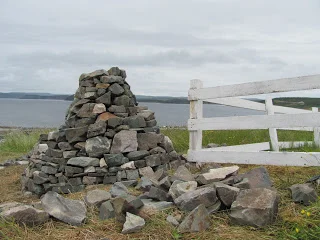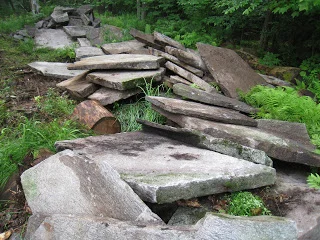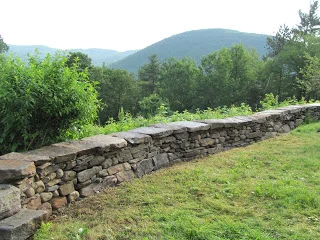The dry stone workshops at English Harbour have been treated to buffeting winds, lightning storms, muffling fog and dazzling sunshine over these past two weeks. Participants have gone from working in tee shirts to suiting up in insulated rain-gear. Whatever the weather conditions of the day (or hour) it’s been exhilarating working on the Newfoundland coast. The wide vistas of boreal forestland and ever-changing seascape have made a dramatic backdrop to our dry stone activities.
Read MoreHaving the fresh supply of stone at my disposal, from last week’s harvesting, has been like getting a blood transfusion for the imagination. I can design with select pieces in mind. I knew when I saw the 6’x7’ slab in the jumble of stone that came off the hillside in Townshend that it was destined for this project in Dummerston.
Read MoreLast week’s stone gathering was harsh work in a tranquil setting. The side-hill that I harvest loose stone from is a mile into the woods up a steep trail. Until the Clark’s and I invaded the scene with loading and transport equipment it was peaceful wilderness. A working landscape, by definition, must tolerate periodic disruptions. The stone I collect from the property will keep me supplied in dry stone construction materials for two years, building things like the barbecue table I made for my friends Peter and Phyllis. Saturday evening’s cookout at their place was as delicious as the sky was dramatic.
Read MoreThanks to Sunny Wieler from Ireland for the mention of Sky Watch on his recent stargazing in the garden article - and for telling me about these beautifully hand crafted garden telescopes - also from Vermont.
Read MoreThe road to a project’s completion is often a long and winding one. That’s why it’s worth taking time along the way to enjoy the view. The installation I’ll be doing at TICKON in Denmark later this summer began last year with an invitation from the art park to submit a proposal. Over the months, conversations and emails have taken the proposal through a series of development where I now feel that all the parts are in place to begin the work.
Read More5,000 years ago, in the land that is now Denmark, the dead were entombed in boulder chambers. Dolmens, as they are known to archaeologists, were once covered with earth mounds. Exposed by erosion and excavation, many are now visible on the landscape. I’m intrigued by these constructions. A three-boulder base supports a one-boulder roof. The simplest of forms proves to be the strongest and most durable. Dolmens, like the ones at Lindeskov, were reused over many centuries.
Read MoreSometimes a single stone is just too big to lift with available equipment. A simple solution is to turn it into two. A rotary hammer armed with a masonry bit will drill six, ⅝” holes in less than ten minutes. Wedge and shim sets are tapped into the holes until a seam opens and the stone pops apart.
Read MoreMy interview on Vermont Public Radio is airing at noon today - most likely after the segment on under-age drinking parties.
Jane Lindholm visited me at work in Dummerston last week for a feature on this month's installment in Vermont Edition's "Visiting Artists" series. Click on VPR's Vermont Edition for more info.
Read MoreThis week I put in a couple days on a “subscription” wall. Every year the customer asks me to add another six yards to its length. They budget a set amount per year for stone work and I schedule it as I wish. This is the third year for this 2’x2’ construction. It follows the circuitous lawn edge at the brink of an embankment. The top line of the wall follows the undulant topography of the lawn. The longer it grows the wigglier it gets.
Read MoreThe Stone Trust wraps up its spring season of dry stone walling activities with an open house this Sunday from 1-4 at Scott Farm. It’s been a productive first year for the organization, with a successful slate of volunteer days, workshops, DSWA tests, pre-test trainings and a two-day Instructor’s course. Anyone and everyone with an interest in preserving and advancing the art and craft of dry stone walling is invited to attend. There will be lemonade, cookies and casual conversation. Please stop by the 1862 barn to say hi, meet members of the board of directors and see what a first-class, four-season, training and testing centre looks like.
Read MoreThe trees in the parks of Helsinki were beginning to show signs of awakening from their winter sleep when I arrived here early May. Today, my last day in Finland on this trip, they are flush with lush green leaves. I leave behind good friends, old and new. It’s been an exciting few weeks of city life. The Kerava Art Museum exhibition is now open to the public until August 28 when the artist’s pieces will be dismantled and moved, or recycled. I’m pleased with the way my two works came out. ‘L.E.M.’ is the small stone and steel construction displayed inside the museum in partnership with Tristan Hamel’s silk-paper globe. Outside, ‘Wishing Wells’ invites museum-goers and passer-by’s to walk through and around its canyons and cavities.
Read MoreBelow is the gist of my presentation for the artist’s seminar that preceded the opening of the show at Kerava Art Museum yesterday. The title and theme for this exhibition is ‘Hole in the Universe’. I don’t know how it sounds in Finnish but the word ‘hole’, in English, can be heard as ‘whole’; with a ‘w’. So the title, when spoken, can be interpreted in two ways. Both are interesting concepts to ponder, and respond to by making art. A hole can be a void, a container or a passage way. To become whole in the universe, complete in mind, body and soul, is perhaps the ultimate artists’ quest.
Read MoreThe techniques used to set stones in relation to one another can be varied. The sizes and shapes of the stones in any supply are often the final determining factor in the design of a dry stone structure. The supply limits the possibilities, focusing the process of design on what is doable. Limits actually increase the potential for a successful outcome. By first assessing the qualities of the available stone, a more ornamental or contemporary design might be considered and pursued.
Read MoreThe techniques used to set stones in relation to one another can be varied. The sizes and shapes of the stones in any supply are often the final determining factor in the design of a dry stone structure. The supply limits the possibilities, focusing the process of design on what is doable. Limits actually increase the potential for a successful outcome. By first assessing the qualities of the available stone, a more ornamental or contemporary design might be considered and pursued.
Read MoreThe exhibition, brought to being by sculptor and professor of Environmental Art Markku Hakuri, focuses on the human and the surrounding universe poetically through surprising spatial experiences. On this trip Hakuri has invited his colleagues, renowned environmental artists Juliane Stiegele from Germany, Daniel Snow from the United States and Michal Cimala from the Czech Republic. A Hole in the Universe is born when the world is nudged off its usual orbit and when it is time to see and understand differently.
Read MoreThe dry stone sculpture rising out of the lawn outside Kerava Art Museum is beginning to attract local attention. People on their way to work are slowing down as they pass. Some stop and ask what’s happening. I learned through a student interpreter that one fellow said he liked seeing natural stone being used, that every one has a unique and beautiful shape. The people of Finland are surrounded by rock. Even in central Helsinki, bedrock outcrops are everywhere. Stone is only surpassed by forest and water in defining the nature of the landscape, and the psyche of the Finns.
Read MoreThe first full day of sculpture making at Kerava Art Museum brought one form to completion. Because this is a temporary exhibit, I’m building directly on the lawn grass. The granite pebbles and cobbles are easy to handle and a nice change of pace from heavy lifting, even though I do have to spend most of the day on my knees. Their smoothness makes them a bit slippery. I wouldn’t recommend using them this way for a permanent construction. This type of arrangement is like making a big ring cake out of small potatoes. Thanks to students Lauri, Hannah and Iisa for set-up assistance. And to Jenni M. for stone shifting.
Read MoreYesterday, Professor Markku Hakuri took me for a train and bus ride to check out the site for my installation at the Kerava Art Museum. This morning I went ten miles outside of Helsinki to a look at gravel pit. A ‘tailings’ pile I found there has the right ingredients for making a piece that combines twelve hollow cones into a mound shape. Because a group of university art students will be helping me, it’s important that the stones be easily shifted and lifted by hand, and the cones and mound be definable with lines and guide frames. This afternoon I made a 3-D sketch in clay of the design I’ve been working on in my head for the past couple of days.
Read More
















